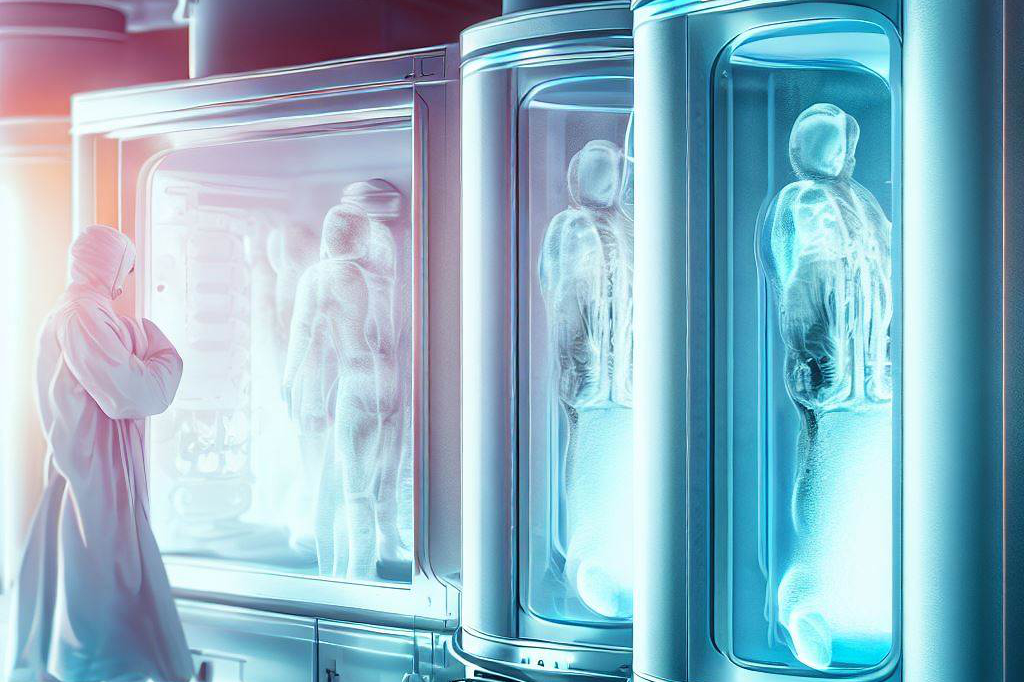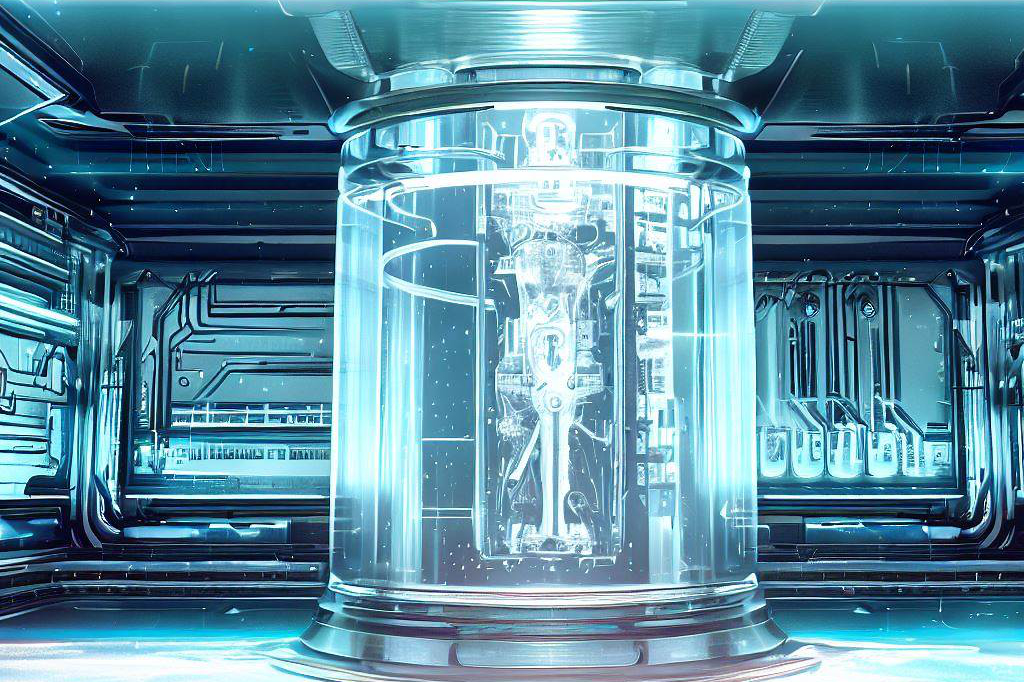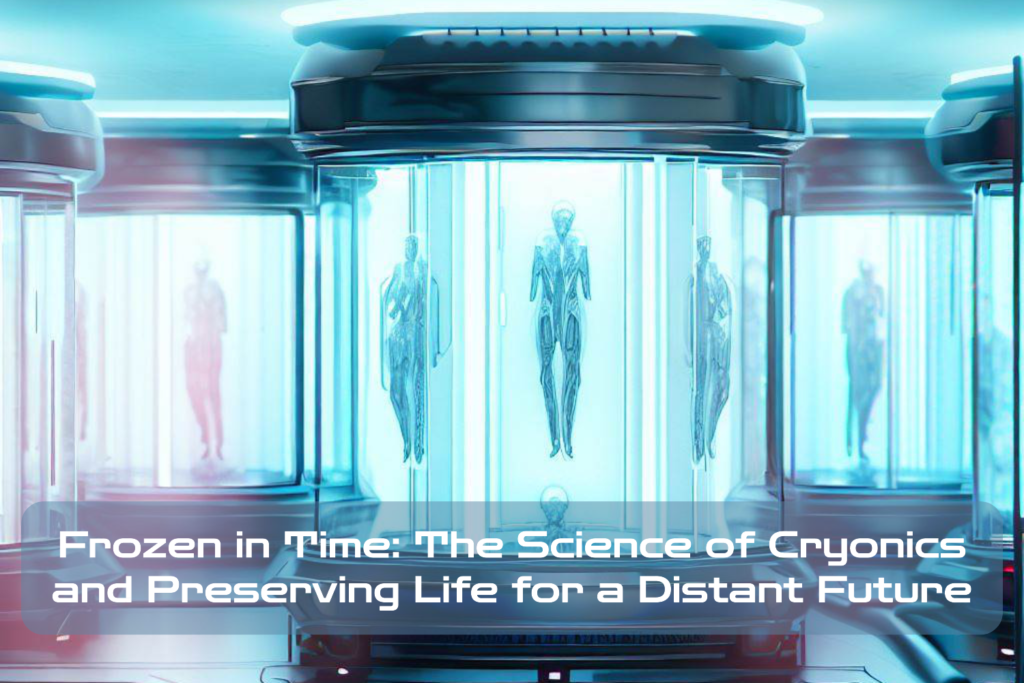Definition of Cryonics and Its Purpose
Cryonics is the practice of using extremely low temperatures to preserve the human body or brain after death, with the hope that it can be revived in the future when medical technology has advanced enough to cure the underlying cause of death. This process involves cooling down the body or brain to -196°C using liquid nitrogen, which prevents further decay and damage to cells and tissues. The purpose of cryonics is to cheat death by preserving life for a distant future.
The idea behind cryonics is that while current medical technology might not be able to revive a dead individual, it may one day reach a point where it can repair damaged cells and tissues, revive patients from cryonic suspension, and even reverse aging. Cryonicists believe that by preserving their bodies or brains through this process, they will have a chance at an extended lifespan or even immortality.
Brief History of Cryonics and Its Development
Cryonics as we know it today began in the 1960s with Robert Ettinger’s book “The Prospect of Immortality,” which proposed using cryogenic freezing as a way for humans to overcome death. In 1967, James Bedford became the first person to undergo cryopreservation after his death from cancer.
Since then, several other individuals have undergone cryopreservation in hopes of being revived in the future. Despite its controversial nature, research into cryonics has continued over the years, with scientists exploring new techniques for better preservation and revival methods.
Today, there are several organizations dedicated solely to offering cryonic preservation services for both humans and pets. While there are no guarantees that this technology will be successful in achieving immortality or extending life spans, proponents argue that it offers hope where there was previously none.
The Science Behind Cryonics

Explanation of the process of cryopreservation
Cryonics is a highly specialized field that involves the preservation of human organs, tissues, and even entire bodies at extremely low temperatures in the hope that they can be revived and restored to full health in the future. The process of cryopreservation involves rapidly cooling biological material to a temperature below -196°C (-321°F), which is achieved by immersing it in liquid nitrogen. At this temperature, all metabolic activity in the cells comes to a halt, thereby preventing further damage and decay.
The role of cryoprotectants in preserving tissues and organs
To ensure that the biological material remains intact during freezing, a cryoprotectant solution is added to prevent ice crystal formation. Ice crystals can have devastating effects on tissues and organs, as they can cause severe damage at the cellular level.
Cryoprotectants help mitigate this risk by acting as a protective layer around cells during freezing, thereby minimizing potential harm. Different types of cryoprotectants are used for different types of tissues or organs, depending on their unique properties.
The use of vitrification to prevent ice crystal formation
One technique used extensively in cryonics is vitrification – an advanced method for preserving both solid objects such as tissue samples and whole bodies. Vitrification essentially replaces water with an antifreeze solution that reduces ice formation at low temperatures and maintains cellular structures without damaging them.
Unlike traditional freezing methods, which create ice crystals within cells, leading to irreversible damage, vitrification preserves tissues at sub-zero temperatures without forming any ice crystals by converting them into a glass-like state where there is no molecular movement or chemical reaction taking place. Understanding the science behind cryonics helps us appreciate why it has been viewed as one of the most promising ways to preserve life for a distant future.
Cryonics in Practice

Examples of Individuals Who Have Undergone Cryopreservation
There are currently over 300 people who have undergone cryopreservation since its inception in the 1960s. One of the most famous examples is baseball player Ted Williams who passed away in 2002 and had his head cryopreserved. Another notable case was that of James Bedford who became the first person ever to undergo cryonics preservation after he died on January 12th, 1967.
Many individuals who opt for cryonics have terminal illnesses such as cancer and hope that they can be revived when a cure is found. Others choose this option due to their belief in future advancements in medical technology or their desire for immortality.
Ethical Considerations Surrounding Cryonics
Cryonics raises several ethical considerations regarding its practice.
One argument against it is that it offers false hope to dying individuals and their loved ones, who may believe that science will one day bring back their deceased relatives.
Another concern is the allocation of resources towards cryonics research and practice, which some argue could be better spent on more immediate medical needs. On the other hand, supporters of cryonics argue that it is a personal choice and that individuals have the right to decide what happens to their bodies after death.
They also point out that cryonics has the potential to advance medical technology in general, leading to benefits for society as a whole.
Overall, cryonics remains a controversial and divisive topic in the medical community, with both detractors and supporters presenting valid arguments for and against its practice.
Criticisms and Challenges

Cryonics is a controversial and oft-criticized field that has garnered skepticism from many people, including scientists, academics, and the general public. One of the most common criticisms leveled against cryonics is its feasibility.
Critics argue that it is impossible to successfully revive a cryopreserved human being due to the damage caused by freezing and thawing. Another major criticism of cryonics is its cost.
The process of cryopreservation can be very expensive, with some estimates placing the cost at hundreds of thousands of dollars per person. This has led some to argue that cryonics is only accessible to wealthy individuals who can afford it, further exacerbating existing social inequalities.
Feasibility
The feasibility of reviving a cryopreserved human being has been a source of debate for decades.
Supporters argue that advances in medical technology will eventually make it possible to repair cellular damage caused by freezing and thawing, allowing for successful revival. However, critics point out that even minor damage at the cellular level can have catastrophic effects on an organism’s ability to function properly.
Some critics have also argued that even if reviving a frozen person were technically possible, it would be impractical due to the massive amount of resources required to do so. Reviving a single individual would require significant investment in medical technology as well as energy-intensive processes such as rewarming and resuscitation.
Cost
The cost of cryonics has been another major sticking point for critics.
Cryopreservation can be incredibly expensive, with some estimates placing the cost at upwards of $200,000 per person. This high price tag has led some experts to question whether or not cryonics is truly accessible or equitable.
Critics have also pointed out that although cryonic preservation may seem like an attractive option for those hoping for immortality, it is not a guaranteed way to achieve this goal. Even if cryonics were to become widely accepted and more affordable in the future, there is no guarantee that those who are cryopreserved will be successfully revived or that they will have access to a world where their frozen bodies can be properly reanimated.
Challenges in Developing Preservation Techniques
Despite advances in medical technology, developing effective cryopreservation techniques remains a significant challenge for scientists. One of the primary issues is the formation of ice crystals during freezing and thawing, which can cause irreparable cellular damage. To combat this problem, scientists have turned to vitrification, discussed earlier – a process where tissue is cooled rapidly enough to prevent ice formation.
Another challenge faced by scientists is developing methods for preserving larger organs such as hearts or kidneys. These organs are much more complex than individual cells and require careful preservation techniques that take into account their size, shape, and structure.
There is also the issue of storage. Cryopreserved bodies must be stored at incredibly low temperatures for long periods of time – potentially centuries or even millennia – without any degradation or cellular damage.
This requires specialized storage facilities equipped with advanced refrigeration technology and round-the-clock monitoring by trained professionals. Despite these challenges, many scientists remain committed to advancing the field of cryonics and exploring new ways to improve preservation techniques.
The Future of Cryonics

Emerging Technologies to Improve Cryopreservation
As cryonics continues to grow and become more mainstream, scientists are continually exploring new technologies to improve the effectiveness of cryopreservation.
One technology that shows significant promise is nanotechnology. By using microscopic particles, scientists can create specialized nanoparticles that can help protect cells during the freezing process.
These particles act as a sort of shield, which can reduce the formation of ice crystals and prevent damage to delicate cell structures.
Another emerging technology is magnetic resonance imaging (MRI) guidance for cryopreservation procedures.
This technology allows doctors to target specific areas within the body, which can greatly reduce the risk of damage or injury during the procedure. The use of MRI guidance also allows for more precise placement of protective agents, which can further improve preservation outcomes.
Potential Applications for Organ Transplantation and Regenerative Medicine
Cryonics has long been touted as a way to extend human life by preserving vital organs and tissues until such time as they can be successfully transplanted back into a living host. While this goal remains elusive, recent advances in regenerative medicine suggest that it may be possible in the not-too-distant future.
One approach involves using stem cells to regenerate damaged or diseased organs.
With properly preserved tissue samples, researchers could extract undamaged stem cells and use them to grow new organs outside the body. This revolutionary technique could potentially eliminate the need for organ donors altogether.
Another potential application for cryonics is in treating degenerative diseases such as Parkinson’s and Alzheimer’s. By preserving brain tissue at temperatures nearing absolute zero, neuroscientists may be able to study how these conditions operate on a molecular level and potentially develop treatments or cures based on their findings.
The Ethical Implications of Cryonic Preservation
Despite its potential benefits, cryonics remains a highly controversial and ethically complex field. Opponents argue that the technology is unproven and that the resources required to preserve a single individual are much better spent on more traditional methods of medical research.
Others view cryonics as an attempt to cheat death, with potentially catastrophic consequences for society as a whole. If cryonic preservation were to become widely available, for example, it could create massive disparities between those who can afford the service and those who cannot.
Despite these concerns, many proponents of cryonics believe that it represents one of the greatest scientific advances of our time. By exploring new technologies and pushing the boundaries of what is possible, they hope to unlock the secrets of both life and death – ultimately leading to longer, healthier lives for all.
Final Thoughts

Despite its challenges, cryonics has the potential to revolutionize medicine by offering new possibilities for preserving life in a way that was once thought impossible. As technology advances, it’s likely that we will see improvements in preservation techniques and increased acceptance of cryonics as a legitimate medical practice.
As we look towards the future of medicine, it’s exciting to imagine a world where death is no longer inevitable but instead simply another phase of life. While there are certainly risks involved with cryonic preservation, there are also enormous potential benefits that cannot be ignored.
Ultimately, only time will tell what impact cryonics will have on our world. But one thing is certain: this controversial field has already sparked important discussions around what it means to be alive and how far we are willing to go to extend our lives into an uncertain future.

C M, a seasoned editor, journalist, and consultant, is deeply fascinated by the convergence of technology, space, and the future of humanity.
With a particular interest in transhumanism, futurology, and the philosophical and ethical dimensions of these domains, C M serves as the lead contributor to TranscendSphere and SpaceSpotlight.
When not penning insightful articles on these rapidly evolving fields, C M indulges in their love for podcasts and books, proudly embracing their status as a ‘Happy Nerd Extraordinaire!’





